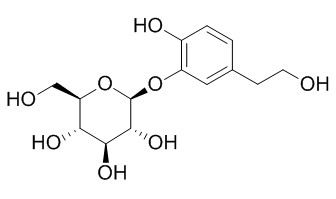Cimidahurinine
Cimidahurinine can attenuate Doxorubicin (DOX)-induced cardiotoxicity in a dose-dependent manner with EC50 values of 45.79 uM; it protects against cardiotoxicity by decreasing reactive oxygen species (ROS) accumulation and downregulating apoptosis-related Bax/Bcl-2 proteins.
Inquire / Order:
manager@chemfaces.com
Technical Inquiries:
service@chemfaces.com
Tel:
+86-27-84237783
Fax:
+86-27-84254680
Address:
1 Building, No. 83, CheCheng Rd., Wuhan Economic and Technological Development Zone, Wuhan, Hubei 430056, PRC
Providing storage is as stated on the product vial and the vial is kept tightly sealed, the product can be stored for up to
24 months(2-8C).
Wherever possible, you should prepare and use solutions on the same day. However, if you need to make up stock solutions in advance, we recommend that you store the solution as aliquots in tightly sealed vials at -20C. Generally, these will be useable for up to two weeks. Before use, and prior to opening the vial we recommend that you allow your product to equilibrate to room temperature for at least 1 hour.
Need more advice on solubility, usage and handling? Please email to: service@chemfaces.com
The packaging of the product may have turned upside down during transportation, resulting in the natural compounds adhering to the neck or cap of the vial. take the vial out of its packaging and gently shake to let the compounds fall to the bottom of the vial. for liquid products, centrifuge at 200-500 RPM to gather the liquid at the bottom of the vial. try to avoid loss or contamination during handling.
Eur J Pharmacol.2023, 951:175770.
Molecules.2016, 21(6)
Molecules.2024, 29(23):5632.
ACS Omega2020, 5,33,20825-20830
J Pharm Biomed Anal.2024, 251:116444.
Pak J Pharm Sci.2023, 36(1):51-57.
VNU Journal of Science: Med.& Pharm. Sci.2022, 38(2):2588-1132.
JEJU National University2022, 24032.
ACS Pharmacol. Transl. Sci.2023, 3c00129.
Chem. of Vegetable Raw Materials2020, 97-105
Related and Featured Products
Food Chem. 2014 Dec 1;164:150-7.
Structural characterisation and antioxidant activity evaluation of phenolic compounds from cold-pressed Perilla frutescens var. arguta seed flour.[Pubmed:
24996318]
METHODS AND RESULTS:
A total of 11 phenolic compounds, as well as sucrose (12) and tryptophan (13), were isolated from cold-pressed Perilla frutescens var. arguta seed flour using column chromatography, and their chemical structures were identified as 3'-dehydroxyl-rosmarinic acid-3-o-glucoside (1), rosmarinic acid-3-o-glucoside (2), rosmarinic acid (3), rosmarinic acid methyl ester (4), luteolin (5), luteolin-5-o-glucoside (6), apigenin (7), caffeic acid (8), caffeic acid-3-o-glucoside (9), vanillic acid (10) and Cimidahurinine (11) using NMR and time-of-flight mass spectrometry.
CONCLUSIONS:
Of these components, compound 1 is novel, and this is the first report of compounds 10 and 11 in perilla seeds.
HPLC quantification combined with antioxidant activity evaluation revealed that rosmarinic acid and rosmarinic acid-3-o-glucoside were the dominant phenolic antioxidants with strong antioxidant activities.
J Asian Nat Prod Res. 2005 Oct;7(5):695-9.
Triterpenoid glycoside from Cimicifuga racemosa.[Pubmed:
16176901]
METHODS AND RESULTS:
One new triterpene glycoside, cimiracemoside (I), and 14 known triterpene glycosides have been isolated from the rhizome extracts of black cohosh (Cimicifuga racemosa).
On the basis of spectral and chemical evidence, the structure of the new compound was elucidated to be 12β-acetoxycimigenol-3-O-β-d-xylopranoside (1), and the known compounds were identified to be 25—acetylcimigenol xyloside (2), cimigenol-3-O-β-d-xylopyranoside (3), acetin (4), 27-deoxyacetin (5), cimicifugoside H-1 (6), 23-O-acetylshengmanol 3-O-β-d-xylopranoside (7), foetidinol-3-O-β-xyloside (8), cimicifugoside H-2 (9), 25-O-methylcimigenol xyloside (10), 21-hydroxycimigenol-3-O-β-d-xylopyranoside (11), 24-epi-7,8—didehydrocimigenol-3-xyloside (12), Cimidahurinine (13), cimidahurine (14) and cimifugin (15).
CONCLUSIONS:
The compounds 1–5, 14, and 15 showed weak antibacterial activities in the agar diffusion assay.
Rsc Adv., 2015, 5(129):106431-8.
A dual-fluorescent whole-well imaging approach for screening active compounds against doxorubicin-induced cardiotoxicity from natural products[Reference:
WebLink]
Doxorubicin (DOX) is an effective chemotherapy drug for various types of cancer. However, acute and chronic cardiotoxicity of DOX hamper its clinical application. There is a great demand for the discovery of drugs against DOX-induced cardiotoxicity. This paper proposed a dual fluorescence cellular imaging assay for screening active compounds against DOX toxicity.
METHODS AND RESULTS:
Whole-well fluorescence images of cells in 96-well microplates were automatically acquired and reconstructed by using a fluorescence microscope coupled with a computer-controlled moving stage. DOX-injured cardiomyocytes were labeled with two fluorescent probes, namely, fluorescein diacetate and Hoechst 33342, to determine cell viability and apoptosis. The linear range and sensitivity of the proposed approach were evaluated and validated by a known active compound, rutin. The proposed approach was also successfully applied in screening active compounds from a clinically used herbal medicine ZhenQiFuZheng granule (ZQFZ), which consisted of two herbs, Astragalus membranaceus (Fisch.) Bunge and Ligustrum lucidum. Five active components were found and were further analyzed by liquid chromatography coupled with mass spectrometry. Hydroxytyrosol, neonuezhenide, salidroside, and Cimidahurinine attenuated DOX-induced cardiotoxicity in a dose-dependent manner with EC50 values of 198.0, 260.4, 621.7, and 45.79 μM, respectively.
CONCLUSIONS:
Western blot results indicated that these active compounds protected against cardiotoxicity by decreasing reactive oxygen species (ROS) accumulation and downregulating apoptosis-related Bax/Bcl-2 proteins. The proposed approach is efficient in screening active compounds from natural products and other complex mixtures.
Zhongguo Zhong Yao Za Zhi. 2010 Apr;35(7):861-4.
[Chemical constituents from fruits of Ligustrum lucidum].[Pubmed:
20575386]
To study the chemical constituents from the fruits of Ligustrum lucidum.
METHODS AND RESULTS:
The chemical constituents from the ethanol extract of L. lucidum were isolated and purified by silica gel, Sephadex LH-20, ODS column chromatographic methods. Their structures were identified on the basis of spectroscopic data and physico-chemical properties. Twenty compounds were isolated and identified as oleanolic acid (1), crategolic acid (2), acetyl oleanolic acid (3), lupeol (4), betulin (5), dammarenediol-II (6), 3beta-acetyl-20, 25-epoxydammarane-24alpha-ol (7), 25-epoxydammarane-3beta, 24alpha-diol (8), dammar-24-ene-3beta-acetyl-20S-ol) (9), 20S, 24R-dammarane-25-ene-24-hydroperoxy-3beta, 20-diol (10), fouquierol (11), oliganthas A (12), dammarenediol II 3-O-palmitate (13), ocotillol II 3-O-palmitate (14), (E) -25-hydroperoxydammar-23-ene-3beta,20-diol (15), verbascoside (16), Cimidahurinine (17), 2-(3,4-dihydroxyphenyl)-ethyl-O-beta-D-glucopyranoside (18), osmanthuside H (19), 2-(3,4-dihydroxyphenyl) ethanol (20).
CONCLUSIONS:
Compounds 4, 16,17, 19 were isolated from this plant for the first time, andcompounds 12-15 were isolated from this genus for the first time.



